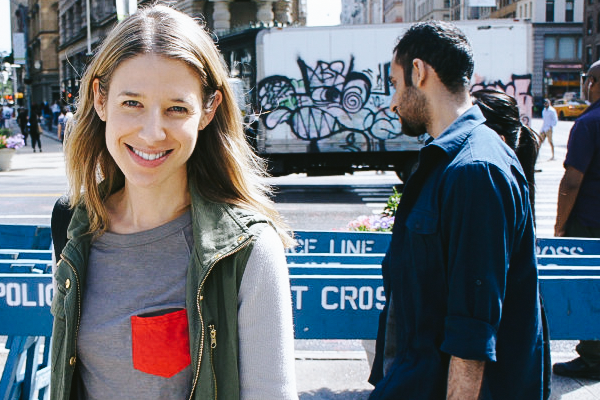Innovating Gotham: Lara Torvi And Modernizing Government Technology

Lara Torvi is the Communications Manager at the New York City Department of Information Technology and Telecommunications (NYC DOITT). NYC DOITT is responsible for modernizing government technology; improving IT infrastructure, service delivery, and civic engagement; increasing digital literacy opportunities for New Yorkers; and facilitating a more transparent and open government. In her free time, Lara helps run CART NY, a non-profit that supports and promotes the contemporary Canadian art community in New York City and around the world.
Q | In one sentence, what do you do? I help bring people closer to government through technology.
Q | Why do you work in government? I’m fascinated by the intersection of technology and public service. There are so many ways government can harness technology and I love seeing the direct impact of that work. I’m also driven by the challenges of an organization as big and complex as local government.
Q | Why do you work in New York City? I wanted to be a part of the growth of New York’s many digital tech initiatives. Working in the City’s technology agency has given me the opportunity to be directly connected to all of the innovation happening here.
Q | What does your typical day look like? My days are pretty unpredictable, which I love, but typically I’m liaising with different departments, other agencies, and external partners to provide input and get updates on various projects. This extends beyond New York City – I frequently host visiting delegations from other cities, states, and countries to share ideas and experiences in civic technology. I also spend time responding to press inquiries, preparing communications content, and monitoring our digital channels. In my role, something can happen at any moment and you’re completely thrown into it.
Q | What is the most challenging part of your job? Most of what we do is highly technical, so there is an added level of translation required to convey the benefits to the public. We’re also connected to a vast number of initiatives through technology, with internal and external communication priorities. Ensuring that we’re reaching our many stakeholders – whether other City employees, New Yorkers, visitors, or the media – and measuring that reach can be quite complicated.
Q | What work are you most proud of? I’m really proud of New York City’s open government efforts. We’ve built up one of the country’s leading open data programs with 1,100+ data sets from 80+ City entities. We’ve participated in dozens of hackathons. Everyday we get closer to becoming a City platform for innovation with more and more lasting uses of our data: creative apps, businesses, analytics projects, and more. It’s an incredible movement!
Q | What has been your most recent “aha!” moment? Our agency is working on a number of human-centered design pilots. Through these pilots we’re applying startup principles to our traditional development process, like working in small interdisciplinary teams and rapidly prototyping solutions. It’s working! We’ve already developed some really transformational tools, which will launch in the fall.
Also, I’ve been thinking about the idea of innovation labs in government. I think it’s often assumed that these labs should be placed outside of government – but there are a lot of really brilliant minds and really important happenings buried deep within government. We just need to figure out a way to connect with them and tease them out.
Q | What is the one thing you would change in government? I want to see government have the ability to experiment more with emerging tech tools and platforms. If there was some sort of space for this work within the public sector to connect with subject matter experts in areas like security, privacy, and accessibility, there might be more opportunity for innovation.
Q | What one person or organization would you like to work with? The work happening at the Centre for Social Innovation in Toronto and here in New York City is so impressive. They are bringing together a diverse network of social innovators, enabling amazing collaboration, and doing it in a sustainable way. I’m really interested in the intersection between social enterprises, like Centre for Social Innovation and local governments. I want to work with the people that are helping create the connections, who aren’t interested about where they themselves fit, but who are bringing everybody together regardless.
“This data visualization by Andrew Hill used data from NYC Open Data and displays vehicle collisions aggregated by time of day using recently released NYPD motor vehicle collision data.”
Q | What inspires you? I’m inspired by New York City’s civic hacker community. Groups like the NY Tech Meetup and betaNYC have helped build an incredible base of technologists that devote their tech skills and time to helping the City address and solve shared civic challenges. This community helped pass New York City’s landmark open data legislation in 2012 and continues to work proactively to improve government through data analysis and apps.
Q | What gets you up in the mornings? A good strong cup of coffee! Seriously, though, it goes back to never having a typical day. I’m often sitting up in bed really quickly going, I’ve got to look at my calendar! What’s going on today? What events are happening? Where am I going to be? There’s so much going on in New York and that’s exciting. I love knowing that each day brings inspiration, new connections, and the opportunity to provide greater access to local public services.
Q | Words of advice for someone early in their career?Don’t be afraid about going down the wrong path. If you have an open mind, it’s going to be OK. There’s no right or wrong direction if you’re engaged in your work and making a difference.
Q | What do you want your legacy to be? I want my legacy to be that I’ve helped people participate in shaping how government works, what it does, and what it delivers.
Learn. Connect. Act.
Learn more about NYC Open Data
Connect via Facebook and Twitter
From the Editor
At Conscious, we are inspired by remarkable people, and so we set out to tell stories that highlight real human interactions and human dignity. You can read more stories like this when you pick up your copy of Conscious Magazine. Subscribe today via our Conscious Shop and subscribe to Conscious Updates.



